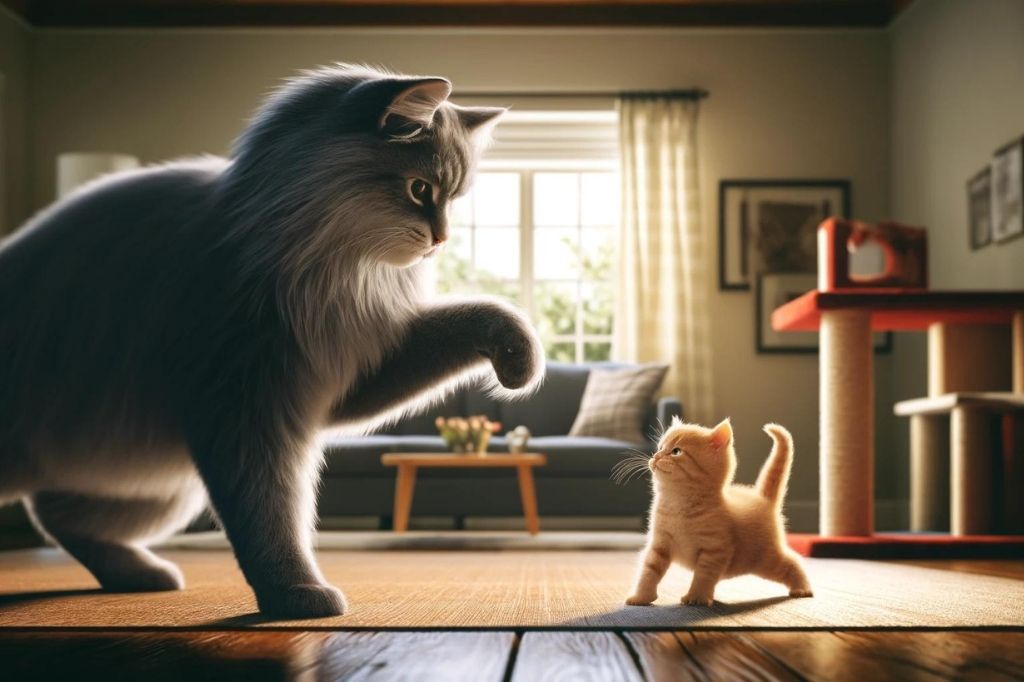Bringing another kitten into your home can be an interesting and blissful time, yet it can likewise raise worries about the communication between your more seasoned cat and the fresh introduction. Noticing their way of behaving intently can assist with deciding if your grown-up cat is only playing or on the other hand if their activities incline towards animosity. This understanding is urgent for the kitten’s security in addition to cultivating an amicable connection between your catlike mates. We should investigate the signs and ways of behaving that recognize perky activities from aggressive ones, giving clearness to the inquiry: Is my cat playing or being aggressive with a kitten?
Understanding Cat Play Behavior
Cats, particularly kittens, are normally perky creatures and have a fundamental influence on their turn of events. It shows them fundamental interactive abilities, coordination, and restraint. Perceiving typical play conduct in cats can assist you with guaranteeing that both your kitten and more seasoned cat are connecting emphatically.
Characteristics of solid play include:
- Gentle Biting: Cats frequently utilize their mouths in play, however, these chomps are regularly controlled and don’t truly hurt. Watch for delicate nibbles that don’t make the kitten shout out in pain.
- Claws Retracted: During play, cats might swipe with their paws however will for the most part keep their hooks withdrawn to try not to harm each other.
- Chase and Retreat: Play frequently includes parts of pursuit, with each cat alternating between being the follower and the sought-after. This proportional way of behaving is a decent sign that the two cats are agreeable and having fun.
- Body Language: Perky cats frequently have a more loosened-up body pose, with ears pointed upwards and forward. Their developments are likewise more liquid and less tense.
These signs can assist with separating fun-loving ways of behaving from animosity. It’s essential to screen these communications and search for consistency in play designs, as this consoles that their relationship is growing decidedly.
Signs of Hostility in Cats
While the play is fundamental for cats, certain ways of behaving are indicative of animosity and ought not to be neglected. Hostility can be unsafe and, on the off chance that not made due, may raise to serious struggles between your pets.
Key indications of hostility include:
- Hissing and Growling: These sounds are obvious signs of distress or outrage and are seldom a piece of fun-loving behavior.
- Biting with Grasped Teeth: Not at all like the delicate chomps found in the play, aggressive gnawing is more extraordinary and pointed toward truly hurting. Such chomps are frequently joined by shaking the head, like how cats assault genuine prey.
- Pinned Ears: On the off chance that your cat’s ears are straightened against its head, it’s an indication of dread or hostility. This is regularly combined with other aggressive signs like washing tails or curved backs.
- Stalking and Ambushing: If one cat consistently stalks or ambushes the other without proportional play from the kitten, it tends to be an indication of savage aggression.
Understanding these ways of behaving can forestall likely wounds and assist with overseeing negative connections from the get-go before they form into additional huge issues.
How to Oversee and Address Aggressive Behavior?
Assuming you distinguish indications of animosity from your more seasoned cat towards the new kitten, there are powerful methodologies to oversee and address this way of behaving. Establishing a protected and amicable climate is fundamental for the two cats’ prosperity.
Steps to relieve hostility include:
- Separation: At first, keep the cats in discrete regions to give them reality to adapt to one another’s fragrance and presence gradually.
- Supervised Interactions: While presenting the cats, do so under close watch to intercede if the aggressive way of behaving arises.
- Positive Reinforcement: Prize non-aggressive ways of behaving with treats, petting, or play to build up certain interactions.
- Provide Departure Routes: Guarantee that the two cats have the chance to withdraw and escape from one another to keep what is happening from escalating.
Recognizing play and hostility in cats includes noticing their non-verbal communication and ways of behaving intently. By figuring out these signs and knowing how to answer suitably, you can work with a smoother presentation and a more charming connection between your more established cat and the new kitten. Keep in mind, that persistence and steady acquaintances are key to encouraging a quiet conjunction inside your catlike family.

